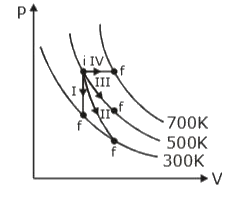Match the following:
Column-IColumn-II(A)Isobaric process(p)No heat exchange(B)Isothermal process (q)Constant pressure(C)Isoentropy process(r)Constant internal energy(D)Isochoric process(s)Work done is zeroSolution in Gujrati
Isobaric process ⇒P = constant
Isothermal process
⇒T= constant
⇒ΔU=0⇒U = constant
Isoentropy process
⇒ΔS=ΔQT=0⇒ΔQ=0
No heat exchange Isochoric process
⇒V = constant ⇒dW=PdV=0
Topper's Solved these Questions
- GEOMETRICAL OPTICSBOOK - ALLEN CHAPTER - GEOMETRICAL OPTICSEXERCISE - ASSERTION-REASON
40 Videos
- GEOMETRICAL OPTICSBOOK - ALLEN CHAPTER - GEOMETRICAL OPTICSEXERCISE - Comprehension Based Questions
66 Videos
- GEOMETRICAL OPTICSBOOK - ALLEN CHAPTER - GEOMETRICAL OPTICSEXERCISE - EXERCISE -02
82 Videos
- CURRENT ELECTRICITYBOOK - ALLEN CHAPTER - CURRENT ELECTRICITYEXERCISE - EX.II
66 Videos
- GRAVITATIONBOOK - ALLEN CHAPTER - GRAVITATIONEXERCISE - EXERCISE 4
9 Videos
Similar Questions
Statement-1: A real gas behaves as an ideal gas at high temperature and low pressure .
Statement-2: Liquid state of an ideal gas is impossible.
View SolutionA certain amount of ice is supplied heat at a constant rate for 7 min. For the first one minute the temperature rises uniformly with time. Then it remains constant for the next 4 min and again the temperature rises at uniform rate for the last 2 min. Given Sice=0.5cal/g∘C,Lf=80cal/g.
The initial temperature of ice is
View SolutionA triangular plate has two cavities , one square and one rectangular as shown in figure . The plate is heated.
_E01_066_Q01.png)
View SolutionIn the Bohr's model of hy drogen atom, the electron moves around the nucleus in a circular orbit of radius 5×10−11m. Its time period is 1.5×10−16s. The current associated with the electron motion is:-
View SolutionAssertion : The difference in the value of acceleration due to gravity at pole and equator is proportional to square of angular velocity of earth.
Reason : the value of acceleration due to gravity is minimum at the equator and maximum at the pole.
View SolutionPV = n RT holds good for A) Isobaric process B) Isochoric process C) Isothermal process D) Adiabatic process
View SolutionOne mole of a monatomic ideal gas is taken througlh a cycle ABCD as shown in the P-V diagram Column II gives the charctierstic involved in the cycle. Math them with each of the processes given in Column-I {:("Column"-I,"Column"-II),((A)"Process" A to B,(p)"Internal energy decreases"),((B) "Process" B to C,(q) "Internal energy incerease"),((C) "Process" C to D,(r)"Heat is lost"),((D) "Process" D to A,(s) "Heat is gained"),( ,(t) "Work is done on the gas"):}
View SolutionThermodynamic processes are indicated in the following diagrams Match the following {:(,"Column - I",,"Column -II",),(P,"Process I",a,"Adiabatic",),(Q,"Process II",b,"Isobaric",),(R,"Process III",c,"Isochoric",),(S,"Process IV",d,"Isothermal",):}
View SolutionColumn-IColumn-II(A)Isobaric process(p)No heat exchange(B)Isothermal process (q)Constant pressure(C)Isoentropy process(r)Constant internal energy(D)Isochoric process(s)Work done is zero
View SolutionMatch the columa- I
Column IColumn II(A)Adiabatic process(P)Combustion in a rigid insulated container(B)Isochoric process(Q)Polytropic index =∞(C)Isothermal process(R)Movement of heat from hot body to cold body(D)Isobaric process(S)CDiamond→CGraphite(T)Work is done by using internal energy
View SolutionColumn IColumn II(A)Isothermal process(p)q=ΔU(B)Adiabatic process(p)w=−pPΔV(C)Isobaric process(r)w=ΔU(D)Isochoric process(s)w=nRTln(V2/V1)
(a) A−s,B−q,C−r,D−p (b) A−s,B−r,C−q,D−p (c )A−p,B−r,C−q,D−s (d) A−r,B−p,C−s,D−q
View SolutionMatch the following {:(,"Column-I",,"Column-II"),((A),"Isothermal process",(p),"Temperature changes"),((B),"Isobaric process",(q),"Pressure changes"),((C),"Isochoric process",(r),"Volume change"),((D),"Cyclic process",(s),"Initial and final states are same"):}
View SolutionThermodynamic processes are indicated in the following diagram.

Match the following :
Column-1 Column-2
P. Process I a. Adiabatic
Q. Process II b. Isobaric
R. Process III c. sochoric
S. Process IV d. Isothermal
View SolutionAn ideal gas undergoes four processes: isochoric, isobaric, isothermal and adiabatic. In which process is (i) the change in internal energy zero?
View SolutionAn ideal gas undergoes four processes: isochoric, isobaric, isothermal and adiabatic. In which process is (ii) the work done zero?
View SolutionAn ideal gas undergoes four processes: isochoric, isobaric, isothermal and adiabatic. In which process is (iii) the heat exchange zero?
View Solution
